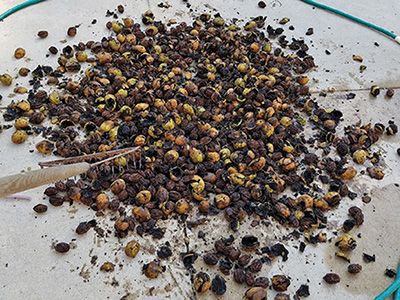The newest publication out of the Hardwood Tree Improvement and Regeneration Center (HTIRC) with the Purdue Department of Forestry and Natural Resources is not only spreading the word about seed propagation protocol for pure and hybrid butternut trees, but is also setting the standard for future publications.

This exhaustive research, which features step by step photo how-to’s, is found in a new paper called Seed Propagation for Pure and Hybrid Butternut (Juglans cinerea) created by PhD candidate Andrea N. Brennan and Dr. Douglass Jacobs, which will be published in the Tree Planters’ Notes, an applied U.S. Forest Service journal.
Seed propagation is essential for conservation and restoration efforts to save the endangered butternut, by helping increase the number of individuals on the landscape with genetically diverse material. The goal of this research was to develop methods for propagating the species by seed at multiple different scales

The butternut is a species that is important both economically and ecologically with its valuable, veneer-quality wood, and through its large seeds that support wildlife.
This research was meant to support any person wanting to grow butternut from seed, from the home grower to the land manager to the researcher, and alternatives for growers at different scales are provided throughout the protocol.
The publication was created as the HTIRC aimed to grow a diverse set of seedlings for an experiment Brennan just completed, which compares the cold tolerance of pure and hybrid butternut.
Hybrid butternut has shown some tolerance to butternut canker, the fungal disease that has caused butternut populations to drop rapidly in the past 50 years.  However, this research is exploring whether these hybrids can fill the same role ecologically as the very cold tolerant pure species, in order to assess the hybrid's suitability as a replacement.
However, this research is exploring whether these hybrids can fill the same role ecologically as the very cold tolerant pure species, in order to assess the hybrid's suitability as a replacement.
 However, this research is exploring whether these hybrids can fill the same role ecologically as the very cold tolerant pure species, in order to assess the hybrid's suitability as a replacement.
However, this research is exploring whether these hybrids can fill the same role ecologically as the very cold tolerant pure species, in order to assess the hybrid's suitability as a replacement.“Basically, this seed propagation protocol should hopefully make it much easier for growers to plant more butternut and for researchers to conduct more research with the species to help save it, as in the experiment I mentioned earlier,” Brennan said.
Jacobs said that due to the step by step nature of the publication including the many photographs, the Tropical HTIRC is planning to use it as a model for its future publications on native Hawaiian forest tree species.





